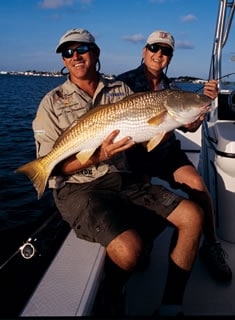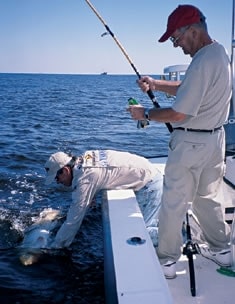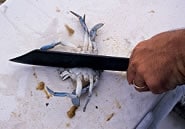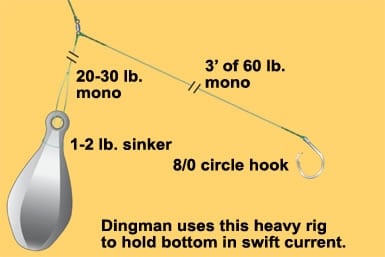
| Captain Don Dingman, left, displays a “modest” St. Johns River redfish taken by Jacksonville angler John Curtain prior to release. River reds typically weigh over 20 pounds, but Dingman has caught them to 54. |
There is great fishing . . . and then there is unbelievably great fishing. I’m talking about the kind of fishing that’s experienced by charter captain Don Dingman. I know, because I’ve fished with him. Seen it. Done it. Photographed and enjoyed it. It’s for real – predictable, in fact. However, you might not believe it until you see it for yourself.
Last year, during a six-week period running from mid-August to early October, Dingman’s charter clients released some 1,600 redfish. These were big fish, too, some weighing over 40 pounds. What’s even more amazing is that they were taken in one of the most populated and heavily boated parts of Florida – right in my own backyard, in fact. I knew I had to experience this fishing for myself, so I tracked down Dingman’s number and made a call.
The friendly guide quickly brought me up to speed on what he was doing, and where, and we set a date to target reds in places I’ve fished for over 25 years. My son, Matt, and I met Don and his daughter, Jacqui, on a bright mid-August afternoon at a public boat ramp in the lower St. Johns River in northeast Florida. The moon was full and the tide was ripping as strong as I’d ever seen it. Don remained optimistic, but I could tell he was worried about the conditions.
His concern was justified. In four hours we caught only eight reds, including a 28-pounder, and lost as many others in the hard-running current of the lower river. Apparently he was so embarrassed about the whole thing that he felt obligated to put us on a huge school of five- to ten-pound black drum.
“I can’t believe the redfish failed me,” Don lamented on our run back to the ramp. “I’ll let you know in a week or two when it gets ‘right’ again.”
Delivering the Goods

Dingman, left, helps Jim Riley boat a hefty redfish hooked at the mouth of the St. Johns River.|
He did, and this time we were joined by my wife, Chris, and her visiting parents, Jim and Rita Riley from Chicago. We fished several spots, and there were reds everywhere we dropped anchor. I honestly don’t know how many we caught, 20 perhaps. Most weighed in the 20- to 30-pound range, and several were well over 30 pounds. Much of the time we had double-headers, sometimes triple-headers, and one time all four of us were battling heavyweight reds at the same time. We could have easily caught more, but we were whipped. We wanted no more of what Don’s big redfish were dishing out.
“Okay, I understand,” he said smiling. “But don’t say we couldn’t have caught more!”
We left ’em biting, as they say – big, beautiful redfish whose arrival in the lower St. Johns is as predictable as the change in seasons.
“I’ve been fishing the August-to-October redfish run in the lower river for over 30 years, ever since I was a little kid,” says the 38-year-old Dingman, who hails from Orange Park, Florida. “The only difference now is that it’s almost all catch-and-release fishing for the heavyweights.” Florida law allows anglers to keep only one red between 18 and 27 inches per day.
The St. Johns reds are spawning-run fish that swarm into the river in immense schools, segregated by sex and size. “The smaller males arrive first, starting about mid-August,” Don explains. “These fish are in the 26- to 33-inch range, most of them over the slot limit. But in a usual day we’ll catch a few we can keep for dinner. They’re in huge schools containing thousands of fish that I easily mark on my depthsounder.

Dingman’s favorite bait for red drum is half a blue crab threaded on a circle hook.|
“And they’re very consistent. Once I locate them along the channel drop-off – in water 25 to 45 feet deep – I can stay on them for a week or so. They move around the river a bit, but I can usually stay with them. I fish about 16 different spots – deep holes right on the edge of the main channel – and they each turn on at different times. This covers about seven or eight miles of the lower St. Johns.”
“Real Bulldogs”
Beginning in mid-September, the number of smaller fish diminishes, and Don and his anglers begin catching much larger reds in the 30- to 40-pound range. Such fish are real bulldogs, especially when hooked in deep water and a hard-running tide. Don’s biggest red in the last six years is a 54-pounder, which is about as big as reds run in the St. Johns.
One key to Don’s success is water depth. “The big schools of big reds feed along the sandbars that drop off quickly into the main channel, 40 or 50 feet down,” he explains. “These places are far from shore, sometimes half a mile or so, where the tide just rips.”
They’re also not far off the ship channel, which is plied by big freighters and oil tankers cruising into and out of Jacksonville. This isn’t easy fishing. Anchoring right on the best spots is critical, and you’ve got to have a good, heavy anchor with plenty of scope. A seaworthy boat is needed, too, because those giant ships throw a pretty good wake.
Fresh blue crabs are Don’s favorite bait for reds, though mantis shrimp and croakers work, too. Crabs are preferred because they stay on a hook well and are less likely to be stolen by smaller fish such as catfish or sharks.
| ### St. Johns Redfish ChartersTo arrange a redfish trip on the St. Johns River with Captain Don Dingman, call him at (904) 276-1164, or visit his website at www.fishingwithdon.com. |
Dingman catches reds on all moving tides, ebb or flood, though different locations are better according to the tide stage. He prefers mid- to late-afternoon fishing, however. He doesn’t know why, but the river redfish seem to feed best in the afternoon.
Catching big reds in deep water and strong current isn’t a light-tackle game, and you needn’t worry about spooking them or using just the right color of lures or flies. These fish are not shy about taking natural baits, and are fought quickly to the surface with hefty tackle (see sidebar).
It’s not shallow-water finesse fishing, but anglers looking to catch a lot of really big reds will find it hard to beat. As Don Dingman says, “If you want to wear out your arms, backs and legs, I don’t know a better place or time to do it than the lower St. Johns in late summer.” You’d better believe it!
Bob McNally is a prolific outdoor writer and photographer whose articles have appeared in most major fishing and hunting magazines. He lives in Jacksonville, Florida. – Ed.
| ### Rigging for River Reds |

¿| When pursuing big, river-run reds, Don Dingman employs heavyweight tackle, the kind of powerful rods and reels you’d use on big grouper offshore. Rods are typically 7 1/2 to 8 1/2 feet long with heavy action and coupled with 2/0 to 3/0 reels spooled with 30- to 40-pound line. This kind of heavy gear allows his clients to bring a big red quickly to the surface, and the reduced fighting time helps ensure that the fish will recover after release.The heavy tackle is also necessary for fishing in the deep water and strong currents of the lower river. It takes a pound or two of weight to hold a bait on the bottom in 25 to 40 feet of water, where the reds feed.Dingman’s preferred terminal setup starts with a three-foot length of 60-pound leader connected to the main line with a stout barrel swivel. The sinker is connected to the fishing line via a breakaway dropper line (lighter than the main line or leader) with a loop on the end. The loop allows him to quickly add or subtract weight as current and depth change. His hook of choice is an 8/0 Eagle Claw L2004 ELF circle hook.Dingman fishes with the rods placed in gunwale holders, and allows the reds to hook themselves on the circle hooks. When the rod bows, the angler simply reels, causing the hook to set in the corner of the fish’s mouth.Live blue crabs are his favorite redfish baits. He carries several dozen large ones in a cooler for a day of fishing. To rig them, he pops off the large top shell, then cuts the crab in half and cuts off the legs at their base. The crab halves are easily threaded onto circle hooks, and are hard for croakers and pinfish steal. – Bob McNally









